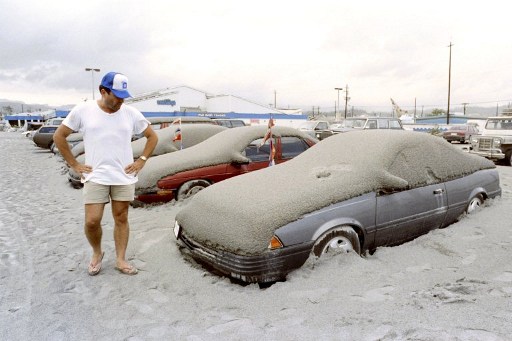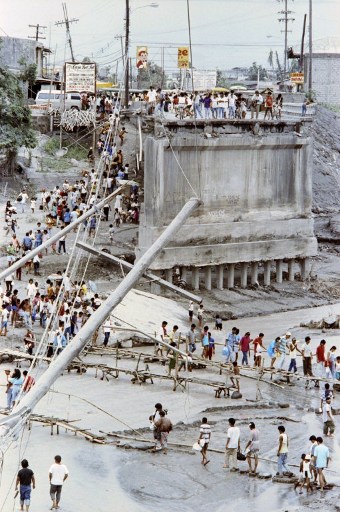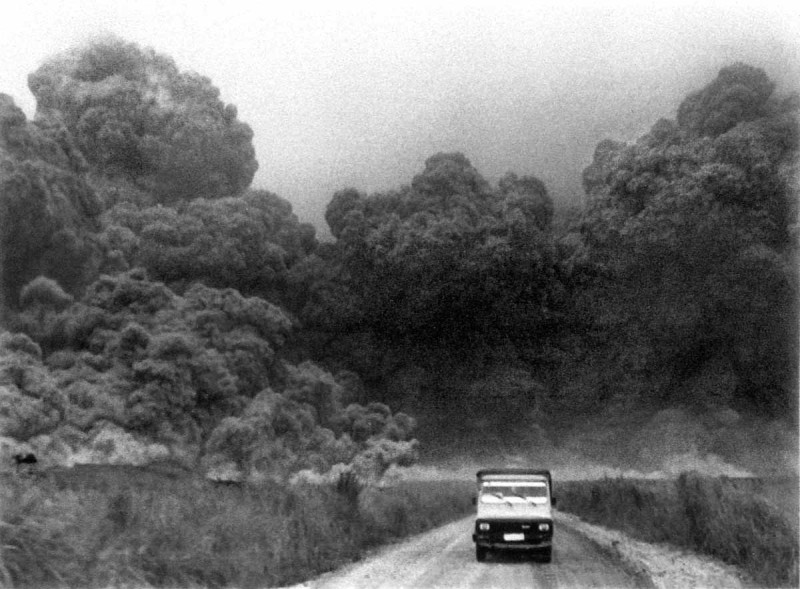Outrunning death: A photojournalist’s escape from Pinatubo
MANILA — I was young and about to get married when I came face to face with death 25 years ago. Death was a huge, grey, cauliflower-shaped cloud that hurtled down the flank of Mount Pinatubo at a speed of a jet plane and to a thundering sound, as if hundreds of horses were galloping down the slopes. To this day, I do not fully understand how I survived.
The cauliflower was the cloud of hot gas and rock from Mount Pinatubo, a volcano in the northern Philippines that, after months of rumbling, spectacularly exploded on June 15, 1991, in the second-largest eruption of the last century that killed more than 1,000 people and spewed so much ash and gas into the air that it lowered temperatures across the globe for several years.
I was a photographer for a Manila-based Japanese news outfit at the time and was in the area with a handful of fellow journalists — Pinatubo had been spewing ash into the sky for weeks, scientists were predicting an eruption, and so we had come to document it.
Although predicted, the eruption, or rather its direction, caught us by surprise and we fled the only way we could — trying to outrun in three vans the cloud of ash chasing us down the slopes. The vans were going at full speed, but compared with the cloud, they felt like they were being drawn by oxen. The moment was preserved in a photograph I took from the rattling rear door of one of the vehicles, showing the giant cloud just behind the other vehicles, looking as if it were about to engulf them.
The 1,000-degree Celsius cloud burned the air and lightning and fire flashed inside, turning everything in its path to ash. Inside the van, I panicked, pulling off my shirt and covering my head with it. The others laughed at me. “Ted, what are you doing? As if it would protect you from this…”
I kept muttering, “I’m going to die, I’m going to die.’ “Shut up!” one of my colleagues shouted at me.
I thought this was it, my end. Thoughts raced within my shirt-covered head: “Oh God, my parents, brothers, sister… and my future wife, what will happen to them, if I die.” Eventually I told myself, “If it’s my end, so be it” and quieted down.
Pinatubo, around a hundred kilometres north of Manila, had been active for several months and I had taken two trips to the mountain to photograph government scientists at their observation post, accessible via an hour-long hike amid lush green tropical vegetation.
I kept muttering, “I’m going to die, I’m going to die.
By early June, the hamlets on Pinatubo’s west flank had become ghost towns, forcibly evacuated by the government after the Philippine Institute of Volcanology and Seismology, also known as Phivolcs, declared a “danger zone” within a 10-kilometre radius from the summit.
After Phivolcs predicted an eruption within days, we returned to the area on June 13.
At daybreak on June 15, hours before the eruption, local television reporter Charie Villa told my group of photographers that the Phivolcs people had told her an eruption the previous night may have killed some residents who had refused to leave their homes. We promptly jumped into three rickety media vans and headed to their village.
As we drove along a dirt road, I heard two thunderous explosions, but thinking we were some distance away and it was safe, we pushed on. All the three vehicles were outfitted with VHF radios through which we communicated. Mobile phones had not been invented at the time.
Suddenly, somebody came on the radio shouting at the top of his voice: “Look up! The eruption is not vertical, it is zooming down right into our path!”
When we saw the monstrous cloud hurtling down the hill, we screamed for our drivers to turn around and drive away as fast as they could. The vans must have been running at top speeds of more than a hundred kilometres an hour, as if they were flying along the rocky road. The cloud looked as if the it was a mere 500-800 metres from us, and rapidly closing in.
After a while one of my colleagues remembered why we were there in the first place. He opened the rear door and began taking pictures of the eruption. “What is he doing?” I said. But I also grabbed my camera and started doing the same. The vehicle behind us looked tiny as it sped just ahead of the cloud. Much later I couldn’t believe I was able to take pictures with the vehicles at top speed. I remembered the door kept banging into our bodies as the three of us swung back and forth taking the photos.
I still do not know how we managed to outrun the cauliflower cloud, but I remember strong winds, part of a typhoon that happened to have struck the area at the same time, and those winds apparently pushed the cloud up into the sky. We couldn’t believe it, we were mesmerised by what happened. Some of my colleagues called it a miracle.
A storm was forecast for the area, but most of us — born, raised and education Catholic — agreed it was a miracle that we had escaped.
Once the cloud stopped chasing us and headed up into the sky, we stopped along the road to take pictures of it. It was an age before selfies, but we all took one, with the mammoth column in the background.
Charie, the television reporter, and some Phivolcs guys found us there and asked us if we were okay.
We proceeded to the volcanologists’ temporary base, a place owned by a religious group that had a life-size statue of the Virgin Mary on the side of one wooden building. Instead of grabbing and packing our things, we gathered in front of the statue and just stood there for almost 10 minutes, looking up at her face.
It was getting dark by the time we decided to leave. It was only 9:00 am, but it was like the end of the world. We had survived the death cloud, but the eruption was still in full progress. Small rocks were falling on the road. As we drove downhill, we met members of a religious group walking in the opposite direction. They wore white robes, praying and saying the end of the world was coming. I was so preoccupied to get out that I managed only a few clicks of the shutter.
We reached the highway about three or four hours later and we headed for Olongapo city, host of a large US naval base where we thought it would be safe. But an hour later residents along the way told us the road to the city was choked with falling sand from the volcanic eruption, so we turned back to where we had come from — the foot of Mount Pinatubo.

A US Navy personnel looks at his volcanic ash covered car at the Subic Naval Base parking lot, on June 19, 1991. The heavy ashfall crushed buildings and covered the entire US Naval facility located some 40 kilometers southeast from Mount Pinatubo volcano, following the 15 june major eruption, the second largest volcanic eruption of the twentieth century. / AFP PHOTO / JOSE DURAN
It was raining sand. All we could see was three to five inches of sand in the road. The vehicles struggled for traction and the windshield wipers failed. To help our drivers, we attached the broken wipers to lengths of rope and took turns leaning out the doors to pull it from one end of the windshield to the other to remove the sand.
We drove north all the way to the province of Pangasinan, at times pushing the vehicles trapped in the thickening sand. The lush tropical vegetation where I had been a few weeks earlier was now a sand-blasted wasteland.
If we stood still for five minutes, our feet would be buried, so we had to move fast to reach safety. After driving for almost eight hours, we reached the provincial boundary and decided to spend the night at a small hospital.
Many locals had also taken shelter there, so we we had difficulty finding a place to sleep except, curiously, for one empty room. As we were dead-tired, we just slumped into the empty stretchers there. We were quite comfortable, as the room was air conditioned.
I woke up a few hours later to find myself alone in the room. I got up and found my colleagues asleep in the crowded corridor outside. I asked them why they gave up the convenience of the air-conditioned room.
One of them whispered to me, “Ted, the room we were staying in was the morgue….” Which explained the air conditioning. “Okay, I’ll sleep in the corridor too.” KS
Ted Aljibe is AFP Manila’s chief photographer. This article was written with Cecil Morella.

Angeles City residents cross the river on improvised wooden bridges, on June 20, 1991 after Abacan was destroyed by flash flood and mudflows from combined effects of typhon, eruption of Mount Pinatubo volcano and earthquakes. The major eruption of Mount Pinatubo on June 15, 1991 was the second largest volcanic eruption of the twentieth century. / AFP PHOTO / ROMEO GACAD
















